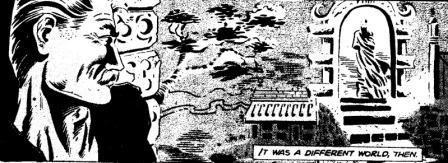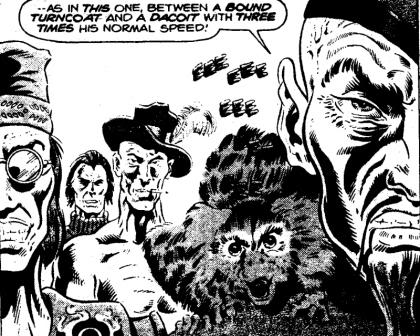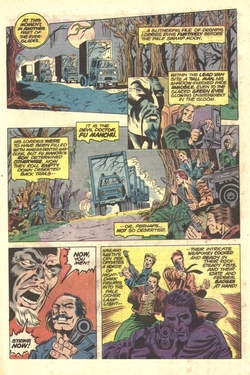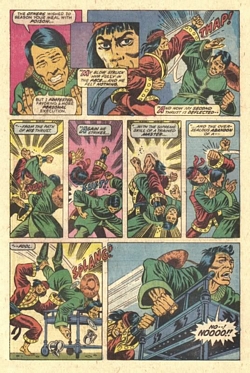
Hi my name's David and I've been a Paul Gulaciac since I first saw his artwork on MoKF #18, back in the early 1970s. I was about 12 years old at the time and I had been a big comics fans since I could read. Besides that, like most of my peers, I was mad keen on Kung-Fu so naturally when my favourite comics publisher released their own Kung-Fu mag, I was wildly enthusiastic. The first three issues were by Jim Starlin, who was a 'fan favourite' at the time (even though the term didn't exist way back then). So I was crushed when I saw an unfamiliar name on the credits of #18 but as you will see, Gulacy kicked things off with a blast. As young as I was, it was obvious he was taking his cues from Steranko but hell, it worked.
Along with scribe Doug Moench, Paul went on to craft some of the most memorable comics of the 70s and made me a fan for life. So much so, that I recently sat down and reviewed Doug and Paul's entire run of MoKF, presented here for your pleasure. I hope you enjoy the results as much as I enjoyed these memories of Kung Fu.
Master of Kung Fu #18 : Attack
by Steve Englehart, Paul Gulacy & Al Milgrom
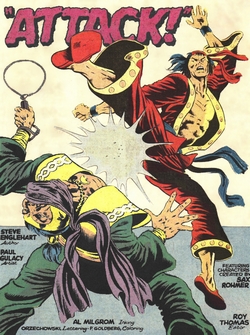 |
The first MoKF two-parter and the debut of Paul Gulacy, who took over from Shang Chi's co-creator, Jim Starlin. And man, Gulacy quickly proved he kicked kung fu ass!
|
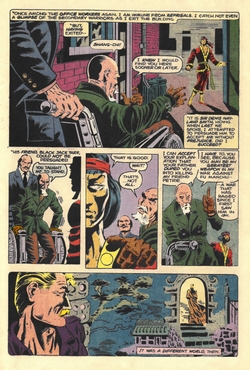 |
I had forgotten how explosive his first issue was and how much promise he showed. The Steranko influences were obvious and his storytelling was smooth, graceful and cinematic. He also brought a distinct pulp flavour to the mag, giving everything an odd, timeless quality. It could’ve been the 1920s or the 1970s. |
|
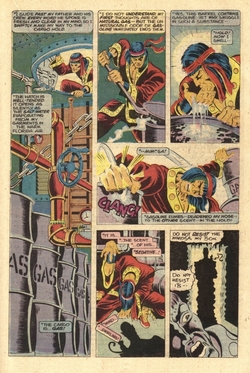 |
Englehart’s writing seemed reinvigorated and he served up a tale involving Fu Manchu smuggling hallucinogenic contraband by ship into Florida. Sir Dennis enlists Shang to stop the dastardly plot but while checking the cargo he gets drugged. Shang has a heck of trip, allowing Gulacy to strut his psychedelic Steranko stuff and he went to town on it. |
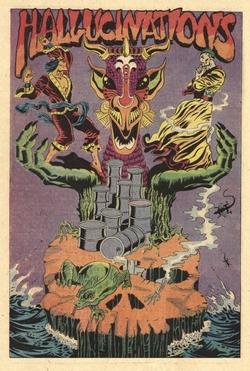 |
It was a great curtain-raiser. And as an added attraction, this issue also introduced another important supporting character, Peko, Fu’s pet monkey.. |
|
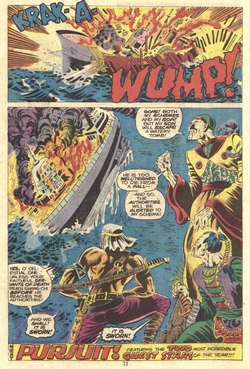 |
At the end of the issue, Shang with his mind blown, returns the favour and blows up the ship before escaping into the everglades, pursued by Fu’s deadly assassins, the Si-Fan. |
|
Master of Kung Fu #19 : Retreat
by Steve Englehart, Paul Gulacy & Al Milgrom
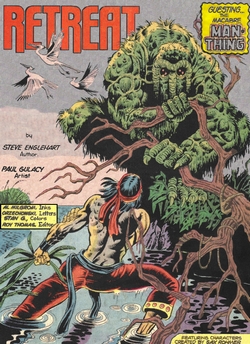 |
#19 was Englehart’s farewell and a fond and poignant farewell it was with Stainless Steve subtlety pointing out the main differences between Shang Chi and TV’s Cain.
|
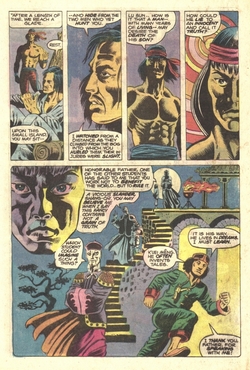 |
In the everglades, while trying to shake his Si-Fan pursuers, Shang meets a Cain lookalike called Lu Sun. The difference between the two men soon becomes apparent. |
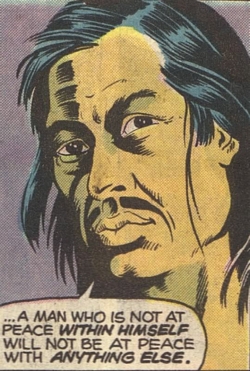 |
Shang was raised to be a living weapon and Lu Sun was trained to be a Buddhist priest. Shang is a man longing for peace who is doomed to seek confrontation. Lu is more secure in his pacifistic convictions and tries to avoid conflict at all costs. Shang feels he must fight his father and his mind is in turmoil, whereas Lu councils him to find peace within himself because ultimately all action is pointless.
He says: “One man may overcome another -- one army may overcome another -- but the world is not changed. Men will always contend.”>BR>
Basically he is telling Shang to give up trying to change the world by confronting the evil of his father and telling him to change himself by finding inner peace. It is the western man of action versus the eastern man of acceptance. |
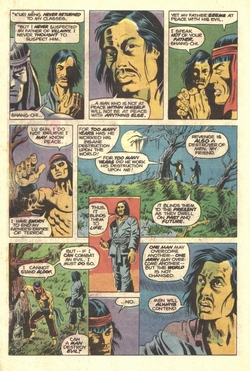 |
Despite the issue’s introspective themes, the pacing is fast and the kung-fu action faster and furious.
Gulacy seems intent on out-Sterankoing Steranko on the action sequences and they are quite breathtaking with their sense of urgency. |
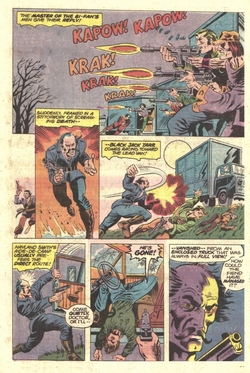 |
Man-Thing’s inclusion makes sense because of the locale but it also makes sense as a foil to Shang, who throughout the issue is wracked with doubts about his self-appointed crusade against his father.
In the end he muses: “The Man-Thing: A mindless mockery of a man, wreaking havoc without thought and how am I so different?”
A good question. One Englehart leaves to the reader to answer.
A neat exit if ever there was one. Kudos to Steve. |
|
Master of Kung Fu #20-21: Weapon of the Soul/Season of Vengeance
by Gerry Conway, Doug Moench, Paul Gulacy, Ron Harris & Al Milgrom
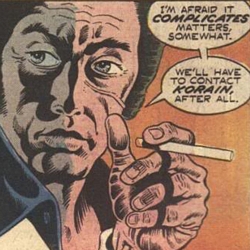 |
This two-parter saw the mag in a state of transition from Steve Englehart to Doug Moench and Paul Gulacy trying to adapt to the rigors of a monthly deadline. It wasn’t a smooth transition by any means.
It tells the tale of would-be wise-guy and Steranko lookalike, Demmy Marston, who wants to ingratiate himself with Fu Manchu by having Shang assassinated.
|
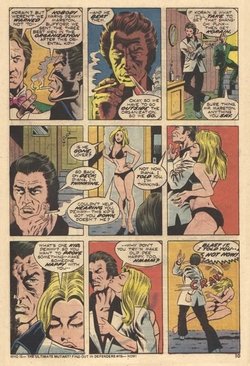 |
Marston is a real two-bit creep and lowlife, who gets off on beating up his curvaceous girlfriend. I have to say the brutality of that scene was quite shocking at the time, literally pulling no punches, once again underlining that MoKF played by different rules than traditional superhero comics.
|
Gulacy’s artwork was a marked step down after his explosive two-part debut. I wonder if this particular story was actually produced earlier for DHoKF and shoe-horned into the colour mag after Englehart‘s abrupt departure. The fact that Conway wrote the first chapter indicates that, and the artwork on the second chapter is marginally better. The second chapter of #20 was Doug Moench’s debut as writer and you can tell he was still finding his voice with some pretty hokey captions and dialogue.
The story was concluded in #21 with “artwork” (I use the term loosely) by Ron Harris. His work is excruciatingly primitive and even makes Gulacy’s poor showing last issue look like Michelangelo. They should’ve redubbed the mag; “Ham-Fisted Hands of Kung-Fu”. The artwork is so bad that the comic is barely readable. The only redeeming things about this issue is a touching scene between Shang and a dolphin, who is brutally killed by one of Marston’s hitmen, which enrages Shang, and the ending in which Fu Manchu rescues Shang and dispatches Marston with a poisonous serpent for having the audacity to try and kill his son. Fu leaves an unconscious Shang behind on a deserted beach, swearing that nobody will kill him but him. The lines were drawn in the sand as it were.
#21 features the immortal cover word balloon: “Eat cold steel pyjama boy!” |
|
Master of Kung Fu #22 : A Fortune of Death!
by Doug Moench, Paul Gulacy & Dan Adkins
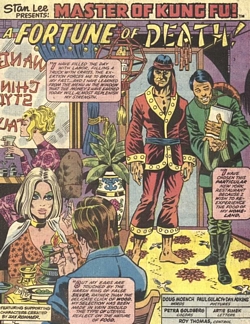 |
A momentous issue under a nice Buscema/Sinnot cover.
Momentous why?
It features the debut of MoKF team supreme of Moench/Gulacy/Adkins.
It was the best issue since #19 and Moench weaves a high-paced tale of pulpish adventure, with Gulacy and Adkins providing the visual fireworks.
|
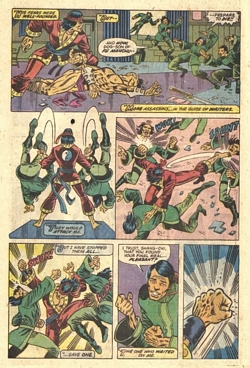 |
You can already see Gulacy developing a new action lexicon, emulating the stylised violence of Kung-Fu flicks. The action seems to move in slow motion at times and then accelerates into gut-wrenching speed. It’s more like a finely choreographed deadly ballet than a superhero fight. This was really something new.
|
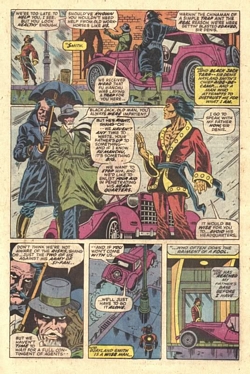 |
Shang decides to arrange his own transport. Naturally the bumbling Smith and Tarr get captured by Fu and his henchmen but Shang leaps in to save the day of course. |
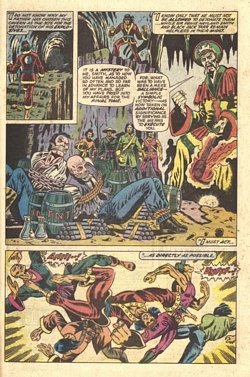 |
The tale comes to a satisfying and surprise ending, presenting a nice, little self-contained adventure in which Shang and co foil a plot by Fu Manchu to achieve a “simple symbolic victory” by blowing up an American landmark. It was a fine showcase of the new team’s great promise….but it would be a long time before that promise would be fulfilled. |
|
Giant-Size Master of Kung-Fu #2 : The Devil Doctor’s Triumph
by Doug Moench, Paul Gulacy & Jack Abel
The only particularly noteworthy thing about this lengthy tale is the introduction of Shang’s first love interest; Sandy, and it’s the first coupling of Gulacy and the notorious Jack Abel. In many ways, this seems like a step back for Gulacy and I wonder if he hadn’t drawn it several months earlier. His lay-outs and particularly his figure drawings are very stiff and awkward.
I pan Jack Abel mercilessly on these boards and not without reason I feel because he ruined many a potential classic. Let me try and articulate exactly what it is about Abel that I dislike so much. For a start, he wasn’t an embellisher so if an artist left stuff out, it stayed left out. That’s not so much a criticism of Abel because it wasn’t particularly his job to make up for the failings of the artists he inked. However, he didn’t add anything to the artwork. On the contrary, he accentuated its shortcomings. Abel also had a tendency to accentuate thick, squarish jawbones which I hated.
The faces here are expressionless and vacuous in general. I also felt his inking line was too thin and weak, sapping all the energy and strength out of the pencils. Everything he inked seemed kinda wishy-washy. Suffice to say, I hate the guy with the same kind of vehemence I reserve for Mike Esposito and Sal Trapini.
|
|


